 |
| Polygonatum biflorum |
After roughly 66 months of writing "plant of the month" posts (I skipped a few since October 2010), I was surprised to discover I hadn't featured Smooth Solomon's Seal (Polygonatum biflorum). This is one of the most reliable, shade-loving, native wildflower plants in my garden. I didn't plant any of them, but they cheerfully nod throughout the garden and woodland every growing season.
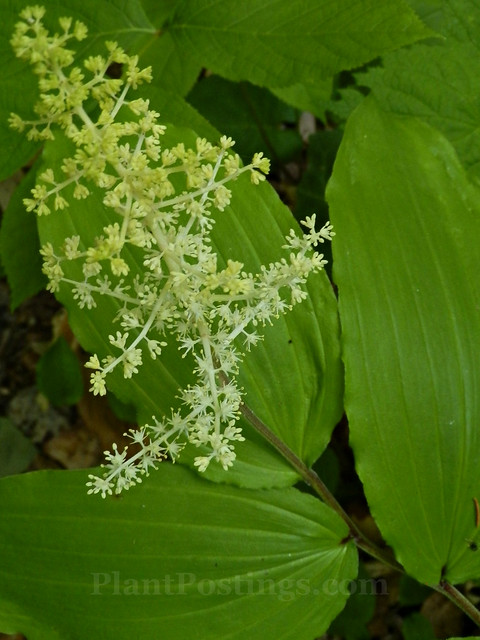 |
| Maianthemum racemosum |
My post today is about Smooth Solomon's Seal, not its closely related "cousin" False Solomon Seal (Maianthemum racemosum), also called Solomon's Plume, which also grows in my woodland. (Also an excellent plant!) The two plants look very similar, but have slightly different growth patterns and very distinct blooms.
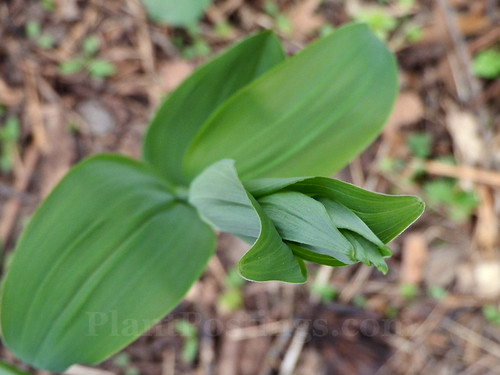
When Smooth Solomon's Seal emerges (as it is now in my garden), it begins as a straight shoot with a green tip, and slowly bends as its leaves unfurl.
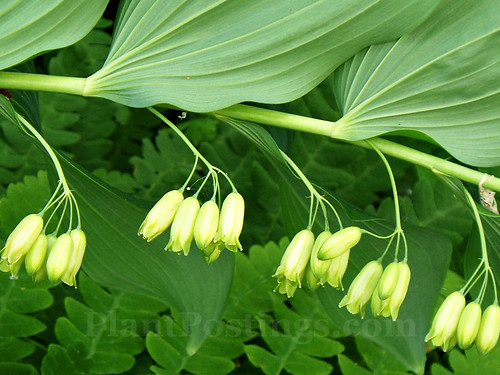
The individual flowers hang like miniature bells under the stems and foliage.
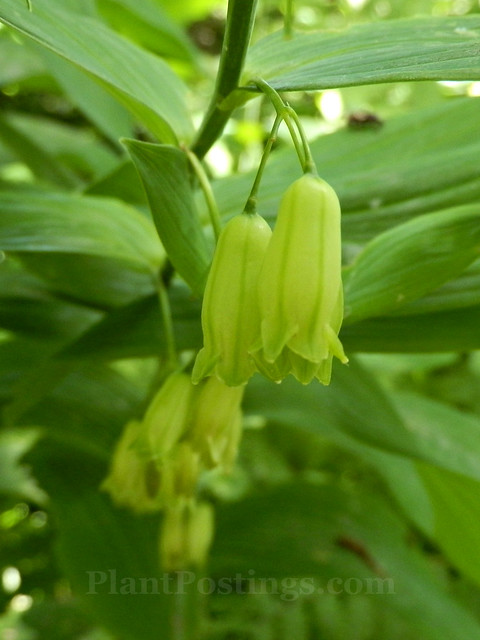
As the blooms mature, their stripes and yellow-green hues gently blend with the plant's foliage.

Even after blooming, the stems and foliage add great structure to cut arrangements.
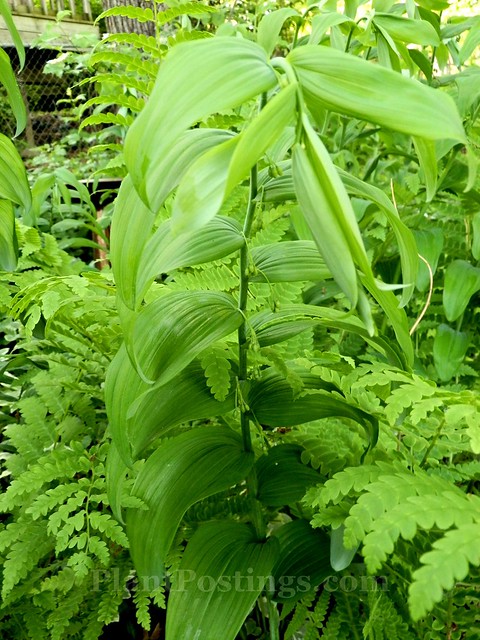
Smooth Solomon's Seal plays well with ferns ...
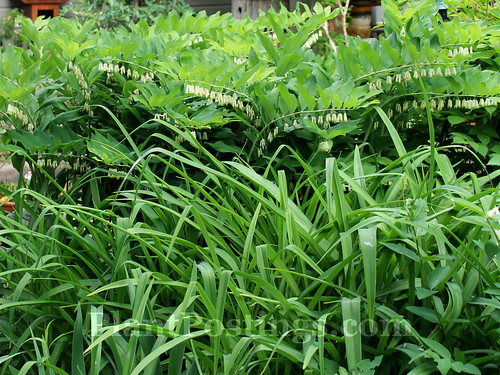
And daylilies ...

And Hosta species and Bleeding Heart (Lamprocapnos spectabilis).
Smooth Solomon's Seal, notes the Lady Bird Johnson Wildflower Center:
- Prefers shade or partial shade;
- Will tolerate sand to clay and dry to moist, acidic soils;
- Attracts birds and butterflies;
- Is native throughout much of North America (USDA zones 3 to 9); and
- Provides food for mammals (roots) and birds (berries).
This plant regularly self-seeds and gently spreads throughout my garden, but I'm usually very pleased with where it lands, since it blends so well with other plants.
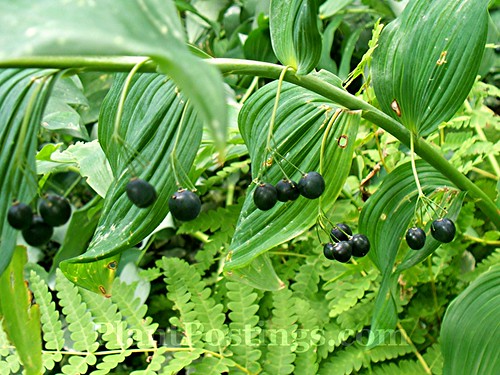
Plus, in late summer and early autumn its dark blue berries are striking (if the birds don't get them first)!
I'm linking this post to Gail's Wildflower Wednesday at Clay and Limestone and Diana's Dozens for Diana at Elephant's Eye on False Bay. Visit their blogs to read about excellent plants growing around the world.
Interesting you describe the Solomon's seal on your blog, a common but valuable plant for the shade. I also have them in my garden together with hostas, ferns and so on but they hardly spread themselves.
ReplyDeleteThey seem to pop up in unexpected places here--some years more than others, probably because of the weather and other conditions. Often, I look and think, hmmmm...maybe I should move that, and then it seems to work in the new spot. :)
DeleteThanks for featuring Polygonatum with great photos. I always struggle to remember the differences between it and Streptopus (twisted stalk), mainly because neither is common here.
ReplyDeleteYou are welcome. I've heard of Twisted Stalk, but I'm not familiar with it. My understanding is that it's more common out East and in Canada? The foliage does look very similar to Polygonatum.
DeleteI don't know overall range, but twisted stalk occurs in much of Wyoming, in mountains where there's more water. It's not so common in our Laramie Mountains which are drier. But I've seen it a few places, along well-shaded streams if I remember right.
DeleteI love mine, with Oxalis at its feet and surrounded by sword ferns. Must remember to check for berries...I've never noticed them. That close-up showing the green stripes is a fantastic shot.
ReplyDeleteThat sounds lovely, Ricki. The berries are attractive, but the birds often get them before I notice them. Thanks. :)
DeleteThis is a really good post for me to read. I'm new at woodland gardening and learning so much! You are right....Solomon's Seal goes well with everything.....I planted some last year and hope it comes back.
ReplyDeleteHi Sally: Woodland gardening can be a little challenging. The native plants are a good bet. I hope your Solomon's Seal comes back, too!
DeleteI love this plant! My variegated Solomon Seal didn't last long, I don't know why, but the green one is doing great.
ReplyDeleteYou have some wonderful combinations there; I love the one with ferns a lot! Thank you Beth!
Thanks, Tatyana. Yes, I do remember some of your posts/photos that included Solomon's Seal. I've never had the variegated version, but it's pretty, too.
DeleteIt's a beautiful plant that tolerates dry shade nicely in my garden. It's a favorite!
ReplyDeleteYes, it performs well in the dry shade areas of my garden, too. I think I take it for granted a little too much, but it's definitely a reliable, graceful stalwart. :)
DeleteA must have for any shade garden. I find volunteers in our woods and shade garden. I love them. I've never thought of cutting them for a vase but that is a great idea!
ReplyDeleteYes, that's my experience, too, Karin. The stems are very sturdy for cut arrangements, and the leaves stay green in the vase for quite a while.
DeleteOh how delicately beautiful are the bells!
ReplyDeleteIs it related to bleeding heart? Both with dangling blooms, a little like the way freesias bloom UP.
They do have similar forms, but the common Bleeding Heart (Lamprocapnos) is in the Papaveraceae family, while this Solomon's Seal is in the Asparagaceae family. I agree--bell-shaped flowers are so appealing. :)
DeleteI have the variegated one and love everything about it - both are fabulous in dry shade and can handle just about anything you throw at them and still look so elegantly beautiful. Nice to see them with the "socks on the line" as my husband calls Bleeding Heart!
ReplyDelete"Socks on the line" -- I like that. I'll never think of Bleeding Heart the same way now. ;-) Solomon's Seal is one of those plants in my garden that's so prolific and reliable that I don't worry about it coming back year after year.
DeleteVery nice pictures Beth, and such a reliable plant.
ReplyDeleteThank you, Alain. Yes, it's definitely reliable and a stalwart in the garden. :)
DeleteA very useful plant in the garden - its grows here in my shady bed but is only just poking it's nose up from beneath the soil right now. They are with Hostas and Ferns. I originally planted them to hang over the pond and what a lovely effect their reflection made but since getting rid of the pond, no not a pond more a puddle really, I still enjoy it.
ReplyDeleteOh, that's a good idea to have some hanging over the pond! I might have to borrow that idea. Thanks! They do look great paired with Hostas and Ferns!
DeleteI have a mini variety of this plant and each year always have to go and look for it in the garden. It arrives at different times depending on our winter. It is such an architectural plant, very graceful and interesting.
ReplyDeleteYes, definitely an architectural plant--both in the garden and as an element in cut arrangements. The ones in my garden have temporarily halted growth since we're having a cool spell. Once the warmth hits again, I'm sure they'll really take off fast.
DeleteWhat a lovely plant - and so versatile too! Not many plants would do well in both dry and shady conditions - it's one to keep in mind once we clear the buckthorn from our wooded area.
ReplyDeleteOh, yes, this would be a great choice for your wooded area post-Buckthorn. The nice thing about it is that it's tall, so it can compete with some of the medium-height and tallish invasives.
DeleteI think it's such an elegant plant. It makes a great combination with bleeding heart, both the Japanese and native species!
ReplyDeleteYes, elegant is a great way to describe it. It's not the "screaming for attention" type of plant, but it's a fabulous companion to so many plants, including the Bleeding Heart species.
DeleteA beautiful plant but I've has it spread a bit more than I would prefer.
ReplyDeleteIt does spread some. It fits some styles of gardens better than others. I really like it here, and I don't mind if it moves around a bit.
DeleteThe perfect woodland plant, it does work beautifully with ferns. And it is a stunning combination with the Bleeding Heart. I shall try that too!
ReplyDeleteYes, the Bleeding Heart combo is nice. Looking at these photos, some of which are from several years ago, I realized again ... areas of the garden where the Solomon's Seal has been and where it tends to go. I've never planted or transplanted it. I don't know if the previous owners were intentional in their use of it, or if it has spread into the garden from the woodland. But I like it in most of the places where it crops up.
DeleteMy mom grows this in her woods garden. I think it is beautiful.
ReplyDeleteCarla
I really like it, too, Carla. It's always been here since we've lived here and I take it for granted.
DeleteGorgeous photos, Beth--just stunning! I want one--or two.
ReplyDeleteThanks, Tina. One or two will probably yield more ... in the ideal conditions for the plant. But it doesn't seem too difficult to keep in check, if that's what you desire.
DeleteI have a lot of the variegated Solomon's Seal but have never noticed berries. Most excellent plant!
ReplyDeleteI've never had the variegated version, but it's attractive, too. They're both great structural plants.
DeleteGreat post. I didn't realize there were two Solomon's seals and have never seen the dark berries.
ReplyDeleteApparently, there are multiple species with the nickname Solomon's Seal. Some of the other ones likely have different types of berries. Although sometimes the berries are gone from mine before I have a chance to notice them--if the birds get them first. ;-)
DeleteI had the False Solomon's Seal on my WW post since it is a native where I live, but Smooth Solomon's Seal is not, I do grow some though. Thanks for the good information, Beth. It does very well and actually spreads more enthusiastically. I never notice the berries on it either, maybe something eats them before I see them.
ReplyDeleteYes, I noticed that you included that one. It's beautiful, too. I'm going to have to watch for the berries this year. To be honest, I take this plant for granted and have only occasionally stopped to look closely for the berries. They're striking, though, in their color and form.
DeleteHello, pretty plants. The Bleeding hearts is one of my favorite. The little bell are pretty. Happy weekend to you!
ReplyDeleteHi Eileen: I love the Bleeding Heart, too. It's such a welcome sight and sign that spring is in full swing. Happy weekend!
DeleteGreat post. I have become a fan of Smooth Solomons Seal in the last couple years, especially after seeing them in Toronto. What do you think of the variegated variety that has become so popular?
ReplyDeleteThanks, Jason. Yes, I noticed them quite a bit in Toronto, too, which gave me a renewed appreciation for them in my own garden. I like the variegated variety, but I probably won't plant it purposely, mainly because I have so many of the straight species P. biflorum in my garden already. Also, the variegated Hostas have such a presence here and would fill a similar niche in their coloring.
DeleteI like seeing your things that are growing and flowering . . .
ReplyDeleteI think when we get from 30 to 60 it might be a color blaze around here.
Everything looks like in "stop mode" right now.
I too have Solomon Seal . . . Not sure how it arrived here!
I know: We've been so cold for late April and early May! Everything was in a holding pattern for about a week. It's starting to warm up now, which is nice because it's comfortable to hang out outside again. :)
DeleteI agree, Solomon's Seal is a fantastic plant and I love it, but can I keep it ? No, it is ravaged by something every year, so never gets the chance to grow and spread. Yours looks lovely!
ReplyDeleteOh, that's too bad! I haven't noticed anything nibbling on mine, which is weird because the rabbits eat so many of my plants. :(
DeleteI love how they look with the other plants. So graceful! A lovely woodland plant!
ReplyDeleteYa, I seriously was scrolling through photos to find some with this plant, and it really struck me how well it blends with and compliments other plants. :)
DeleteI love this plant!!
ReplyDeleteMe, too! I take it for granted, but it's a great plant for dry shade (or shade, in general).
DeleteWhile I grow Variegated Solomon's Seal, Polygonatum odoratum 'Variegatum', I did not know much about Polygonatum biflorum. Thanks for the info and very nice photos. I adore those striped flowers! It combines well with other woodland plants and truly is a great plant for the woodland garden.
ReplyDeleteI enjoy the variegated Polygonatum, too. All are great for woodland gardens. They're wonderful structural plants!
DeleteThis is funny, because last week I was looking at my shade garden and wondered what some emerging stalks were. A few days later, I looked again and realize they were Solomon's Seal. I don't think I've ever noticed it in its early stages before. I love the little bell-shaped blooms along the stems.
ReplyDeleteInteresting that you say that, Rose. I think mine had an early start this year (like so many plants did). Usually, they seem to pop up overnight and grow tall quickly, so I don't notice them much until they're taller. This year, everything popped up in March, stayed in a holding pattern in April, and some are just beginning to fill out and reach their full size. I really like this plant when it flowers and when the berries appear (if the birds don't eat them all).
DeleteCan't say I'm familiar with this one. Love your bleeding hearts!
ReplyDeleteIt's pretty common here. The Bleeding Hearts are like shrubs this time of year. :)
DeleteI love this plant too but have never seen the berries...the birds are too fast for me....great shots Beth!
ReplyDeleteUsually, the birds eat them here, too, but we have so many Solomon's Seal plants that they don't always get to all of them. Thanks, Donna!
Delete